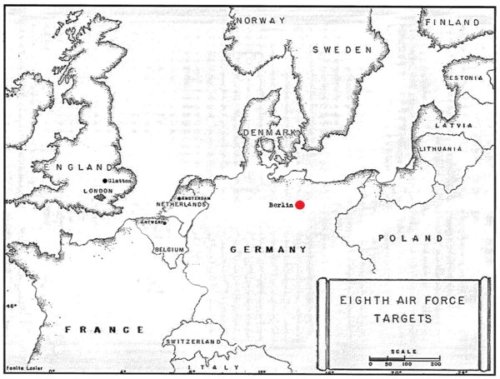TARGET: MARSHALLING YARDS
BERLIN, GERMANY
18 MARCH, 1945

It was back to the railroad complex at “Big B”. In spite of previous bombings, photographs showed the marshalling yards in the target area to be 100% serviceable. The Group comprised the 94th B Combat Wing with Captain Rollins as Air Commander. The Eighth Air Force committed 2,000 planes to bomb Berlin on this mission.
The Group assembled in Wing formation without difficultY and followed in trail for the remainder of the route. On the turn before the first Control Point, the Group swung wide to the left of course, in order to gain more interval behind the Wing Leader.
The Control Point was reached about five miles left of course, in order to avoid interference from other groups on the bomb run. Contrails and clouds caused constant interference along the run.
The high flight of the low squadron was attacked by Me 262s. This element was out of position to the left of the Group formation. The Me-262 attack came from the tail with each jet attacking a B-17. In addition to the fighter attack, the Group was also encountering antiaircraft opposition.
The aircraft piloted by Lt. John W. Schwikert, flying No. 3 position in the high element of the low box, was attacked by a jet and hit on the No. 2 engine. It continued to fly in position for some time before No. 2 engine caught fire and the craft went into a steep dive. The craft dropped out of formation, lost altitude and when it was last spotted, parachutes were observed. The crew became prisoners of war.
Lt. Craig P. Greason’s plane was hit by an Me-262; a large section of the left wing was torn away, the inboard engine was damaged and the fuel tanks were leaking. In spite of the damage, Lt. Greason kept the plane aloft and returned to the Base
The plane piloted by Lt. Edwin Witten feathered an engine after bombs were dropped, left the formation north of Berlin and finally landed in Poland. The crew ultimately returned to Glatton by a circuitous route.
Bombing was done in Group formation by means of combination PFF and visual assist. Cloud coverage was from four to five-tenths; and visibility was poor. The high squadron bombed to the right of the Group formation instead of to the left, because a squadron from another group prevented the craft from crossing over to proper position.
Some difficulty was experienced from heavy prop wash at the BRI Bombs were dropped from 25,000 feet and bomb results were observed to be fair.
After bombing, the Group was unable to sight the Wing Leader because of dense and persistent contrails. Because of the possibility of imminent enemy aircraft attacks, the Group Leader decided to rejoin the Division bomber stream without regard to position.
Between the fighter and flak attacks, the Group sustained its greatest damage in a month. Captain Tom Goff, flying his 38th mission, said it was the first time he was ever on a mission when fighters hit the bombers over the target, saying they came in right through their own flak.
Gunners claimed four confirmed Me-262s. The 457th lost one aircraft; three sustained major damage and five minor.

